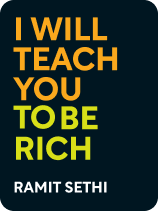

This article is an excerpt from the Shortform book guide to "I Will Teach You to Be Rich" by Ramit Sethi. Shortform has the world's best summaries and analyses of books you should be reading.
Like this article? Sign up for a free trial here .
What is I Will Teach You to Be Rich about? What are the key points of Ramit Sethi’s money advice?
In his book I Will Teach You to Be Rich, self-taught expert in personal finance Ramit Sethi distills the basics of personal money management. You’ll learn how to use credit cards wisely, choose the right bank accounts and investment accounts, plan out your spending, and ultimately create a financial system that grows your money automatically.
Below is a brief overview of the key points.
I Will Teach You to Be Rich by Ramit Sethi
Personal finance can be confusing and overwhelming, but if you focus on taking one small step at a time, you can create a solid financial foundation. Once your finances are under control, you won’t have to worry about money, and you can focus on creating a life you love. The author of the book I Will Teach You to Be Rich, Ramit Sethi, is a self-taught expert in personal finance. His goal is to help you cut through the noise of conflicting and overly technical financial advice, get past your own hang-ups around money, and take small steps toward a “rich life”—whatever that looks like for you.
Credit Cards
If you use credit cards responsibly (by always paying your bill on time, in full), they’re essentially free short-term loans that help improve your credit history, making it easier to get larger loans (like for a mortgage or a car) down the line. Here are the six most important rules for using credit cards the right way:
- Pay your bills on time, preferably in full. Even just one late payment can lower your credit score, raise your annual percentage rate of interest paid (APR), and stick you with a late fee (usually about $35).
- If you’re paying any fees, call your credit card company and get them waived.
- Lower your APR. Ideally, you’re paying off your balance in full every month, but if you’re not able to do that yet, your APR determines how much more you’ll end up paying in total. Calling your credit card company to negotiate a lower APR can save you thousands.
- Keep your accounts open and active. Credit history is an important part of determining your credit score—the longer you keep an account open and continue making on-time payments, the better your score.
- Take advantage of your card’s perks, including automatic extended warranties, airline miles, and rental car insurance.
Paying Off Debt
Getting out of debt not only feels good emotionally, it also boosts your credit score and can save you thousands of dollars in interest. Here’s how to pay off your debt in five steps:
- Step 1: Total up your debt. Many people have no idea how much debt they actually have, which makes it impossible to make a solid plan.
- Step Two: Decide where to start. Focus on fully paying off one card at a time. You can either start with the card with the highest APR or the lowest balance.
- Step 3: Negotiate a lower APR. This will reduce how much you pay in interest.
- Step 4: Figure out how you can afford more aggressive monthly payments. Take a look at your spending habits—where can you afford to cut costs?
- Step 5: Get started. It’s better to get started on a plan that’s mostly solid than to spin your wheels trying to come up with a plan that’s 100% perfect.
Choosing the Best Banks
Together, your credit cards and bank accounts form the foundation of the rest of your financial system. To make sure that foundation is solid, look for accounts with low fees. Fees are how banks make a huge portion of their profits, so low fees are a good sign that a particular bank isn’t trying to squeeze more money out of you for their own benefit.
When you’re looking for a new bank, look for three things:
- Trust. Start by asking your friends which banks they personally trust. Then, browse the websites of those banks. Keep an eye out for excessive fees, minimum required balances, or misleading descriptions of different accounts.
- Convenience. If the bank’s website, app, or other services aren’t convenient to use, you’ll be far less likely to actually use them.
- Features. Make sure the bank offers the basic features you’ll need most: competitive interest rates, free transfers to external accounts, and free bill pay.
Choosing Your Accounts
To start, you’ll need a checking account and a savings account. Here are the ones Sethi personally uses and recommends:
- Schwab Bank Investor Checking with Schwab One Brokerage Account through Charles Schwab Bank. This account boasts an impressive list of features, like zero fees, unlimited ATM fee reimbursements, overdraft protection, and free checks.
- Capital One 360 Savings. Aside from having no fees and no minimums, the main benefit of this account is that you can set up sub-accounts to save up for specific goals (like a wedding or emergency fund).
Investment Accounts
Now that you know how to optimize your credit cards and bank accounts, we’ll turn our focus to opening investment accounts.
The Power of Compounding
Investing is the most powerful way to grow your money because it offers a higher rate of return than even the best savings accounts. On average, the stock market’s annual net return is about 8% (after accounting for inflation). That number is an average from decades worth of data, which means that your money will earn an average of 8% per year over the long-term, even if that rate fluctuates in the short-term.
The reason why that 8% rate is so important is the power of compound interest. With compounding, the interest you earn in a given year is added to the principal (original) amount you invested; then, the following year, you earn interest on that new principal amount.
- For example, let’s say you invest $100 in the stock market (to make things easy, we’ll assume an exact 8% annual rate of return). That means that after one year, you’d have earned $8, for a new total of $108. In the second year, you then earn an 8% return on that new amount, so you’d earn $8.64 for a new total of $116.64. The longer you leave your money in the stock market, the more that principal grows, and the more you earn every year.
The power of compounding also means that the longer you leave your money in the market, the more it grows—which means that the earlier you start investing, the more money you’ll have by the time you retire.
Start by Opening Your 401(k)
A 401(k) is an investment account sponsored by many employers to help their employees save for retirement. When you open a 401(k) account, you authorize your employer to send a certain amount out of each paycheck into that account automatically. A 401(k) is one of the best retirement investment accounts out there for three major reasons:
- The money in your 401(k) is “pretax,” which means it isn’t taxed until you withdraw it. That means your contributions will be much bigger (because they haven’t had taxes taken out of them yet), meaning your principal investment amount is higher, which can increase the compound growth of your investments by 25 to 40%.
- Your employer might match your contribution. That means that every time you funnel money into your 401(k) account, your employer will “match” that contribution up to a certain percentage of your salary. In other words, this is free money.
- You’ll invest automatically, without even knowing it. Your 401(k) contributions come out of your paycheck before you get paid, so you won’t have to worry about investing it yourself—it’s already taken care of by the time you get paid each month.
There is one downside to a 401(k): If you withdraw your money before age 59.5, you’ll incur a 10% early withdrawal penalty in addition to paying income tax on the money. Basically, your 401(k) is exclusively for long-term investing, so you should avoid withdrawing the money early unless you’re absolutely desperate.
Roth IRAs
A Roth IRA is another type of retirement account, but unlike a 401(k), you don’t need an employer to sponsor it. These accounts are only available to people below a certain income level, which changes slightly each year. Roth IRAs also allow you to invest however you want rather than making you choose between a few pre-selected funds like a 401(k).
The other major difference between a Roth IRA and a 401(k) is that the money you invest in your Roth IRA has already been taxed—which means that you’ll pay taxes on the money you put in, but you’ll pay no taxes on the money you earn on top of that. That gives you a huge benefit over a regular, taxable investment account, in which you pay taxes on both your contributions and your returns.
Choosing a Brokerage Firm
To open a Roth IRA, you’ll need an account with an investment brokerage. You should focus on discount brokerages, which offer nearly all the same features as “full service” brokerages, but with much smaller minimum investing fees. (That’s how much money you’ll need before you can actually invest the money in your account. Opening the account itself is always free.) Sethi personally recommends Vanguard, Schwab, and Fidelity as discount brokerages to help you get started investing.
Spending Mindfully
Now that your savings and investment accounts are set up, you need to know how much you can afford to contribute to them every month. To do that, you’ll need a system for spending your money in a way that works for your specific goals, values, and lifestyle. That way, you’ll not only be confident that you’re contributing enough to your savings and investment goals, but you’ll also know that any money left over is yours to spend however you want—with zero guilt.
Deciding How You’ll Spend Your Money
Sethi’s system for mapping out your spending involves dividing your take-home pay into four major areas. The breakdown of these costs should look roughly like this:
- Fixed costs. Fixed monthly costs are your necessities: rent or mortgage payments, groceries, and so on. Add up your total for all monthly costs, then add 15% to cover unexpected expenses like car repair, traffic tickets, or emergency medical treatment. Ideally, your fixed costs should total about 50 to 60% of your monthly take-home pay (the amount on your paycheck after taxes).
- Investments. This category includes contributions to your 401(k), Roth IRA, and any other long-term investment accounts. Investments should be about 10% of your take-home pay.
- Savings goals. This category is for all your savings goals, from short-term (like a vacation) to long-term (like a house). Plan to allot 5 to 10% of your monthly take-home pay for savings.
- Guilt-free spending. Any money you have leftover after accounting for the other categories goes into the guilt-free spending category. This is money you get to use however you like, with zero guilt, because you know you’ve already paid your bills and funded your future through savings and investments. Ideally, this category will have 20-35% of your take-home pay.
Automating Your Financial System
Now that you have a system of spending your money that works for you, it’s time to start automating that plan so that your money divides itself up each month without you having to lift a finger.
How Automation Works
If you’ve ever tried to stick to a budget or keep track of your bills manually, you’ve probably noticed how hard it is to stay on top of your finances when you have to consciously think about where each dollar goes. It’s too easy to get distracted, bored, or overwhelmed, so we end up making costly mistakes. Automation is different: Instead of requiring constant focus, automating your financial system allows you to frontload the hard work by spending a few hours setting up your accounts; after that, you get to move on and focus on other things.
In practice, here’s how automation works: Set up a system of automatic transfers between your checking account, credit cards, bills, savings, and investment accounts. Your checking account will be the central node of this system—once your paycheck lands in that account each month, your system will kick in and initiate transfers from your checking account into all your other accounts based on the percentages you came up with when you mapped your planned expenditure.
Getting Ready to Invest
Now that your pre-planned system of transfers is funneling money into your investment accounts each month, you can start thinking about how to actually invest that money. One crucial thing to note about investing is that funding an investment account is different from actually investing that money. If you set up automatic contributions to your 401(k) and Roth IRA earlier in this summary, you haven’t actually invested that money yet—and it will just sit there, earning zero returns, until you do! This is a common mistake that can cost you thousands of dollars in lost potential returns.
Start your investing journey by learning more about different asset classes, which are the building blocks of investing.
Asset Classes
Asset classes are simply types of investments (like stocks or bonds), and each asset class has varied assets within it. For example, “stocks” is an asset class composed of all kinds of different stocks: large companies, small companies, international companies, and so on. Let’s look at each asset class in more detail, starting with stocks.
Stocks
When you think of investing, you probably think of stocks first. Stocks are shares of ownership in a particular company. Stocks are one of the most unpredictable investments because their value is determined by the shareholders. For example, if a company seems to be doing really well, more and more people will want to buy stock in that company, which drives up the price of each individual share. But if something happens to shake people’s faith in that company (like a merger or a supply shortage), shareholders will start selling off their shares and cause the stock price to drop.
Bonds
Bonds are a different type of asset class. They’re a much more stable investment than stocks because the value of a bond doesn’t fluctuate based on the whims of the market. When you buy a bond, you’re essentially giving a small loan to the bond issuer (which can be the federal government, local governments, or a corporation) with a predetermined payback period. Bonds provide a buffer against market volatility, which means that if some of your investments are in bonds rather than stocks, you won’t lose your entire investment if the market crashes.
Asset Allocation
Now that we understand the building blocks of investing, let’s learn how to combine them into a healthy investment portfolio using asset allocation, which is the division of assets (like stocks and bonds) in your portfolio. Managing your asset allocation is the best way to control the amount of risk in your portfolio because you control how much of your money is invested in higher-risk options (like stocks) versus safer investments like bonds. In other words, the way you distribute your investments is more important than the specific stocks, bonds, or funds you choose to invest in.
Your asset allocation should reflect your risk tolerance. In your twenties and thirties, you can afford to take bigger risks with your money because you have plenty of time to recover from any losses before you retire. However, as you get older, your risk tolerance will decrease (because if you take a big loss in the stock market at age 59, you won’t necessarily have the time to recoup your investment before retirement). Your asset allocation should change to reflect those changes in your risk tolerance.
Target Date Funds
If keeping track of a portfolio full of stocks, bonds, and index funds makes your head spin, don’t worry. There’s an easier way to invest: Target date funds (also called “target retirement” or “lifecycle” funds), which automatically rebalance your investments based on the year you plan to retire. That way, you don’t have to worry about adjusting your asset allocation as you age—a target date fund will automatically reallocate more of your investments into safer options like bonds as you get closer to retirement. These funds also provide automatic diversification because they’re essentially funds made up of other funds, so you can own stock in a huge variety of companies just by buying into a single target date fund.
Financial Milestones
You may be wondering how your new financial system will fit into the rest of your life. In particular, there are a few financial milestones that most people in their twenties and thirties need to consider—like paying for a wedding, negotiating a salary at a new job, and buying a house.
Paying for a Wedding
Studies show that the average American wedding costs somewhere around $35,000—and that the average American thinks their wedding won’t cost nearly that much. Instead of assuming that you will somehow beat the average and have a truly simple, low-budget wedding, take those statistics to heart and start saving for your wedding now—even if you’re not engaged.
To figure out how much you should be saving each month for your future wedding, start by estimating when you want to get married. Then, use that estimate to figure out how long you have to save, and divide the total wedding cost by that number.
Negotiating a Higher Salary
The best time to negotiate your salary is the moment you get hired because you have more leverage. Here are Sethi’s top tips on how to negotiate a higher salary:
- Make the negotiation about the company, not about you. In other words, emphasize the value you’ll add to the company rather than how much your salary will cost them.
- Leverage other job offers. That way, the hiring manager knows you’re not afraid to walk away if she can’t come up with a fair number.
- Negotiate total compensation, not just money. Don’t be afraid to ask for vacation days or stock options as part of your overall compensation.
- Be friendly. Smile often and remember that your goal is to come up with an agreement that works for both of you.
- Let them make the first offer and don’t reveal your salary. This makes it harder for them to make a lowball offer rather than an offer that reflects the real value of the position.
- Practice, practice, practice. Ask your friends to play the role of hiring manager and drill you with the hardest questions they can think of. You’ll feel awkward at first, but try to take it seriously.
Big-Ticket Purchases
Another financial milestone on the horizon for many young people is buying a car or a house. These “big-ticket” items are important because they’re a unique opportunity to save money.
Buying a Car
The first step to buying a car is figuring out your actual budget. To do this, look back at your plan for expenditure to see how much you can afford to put toward the costs of owning a car every month. This isn’t just a car payment: You also need to include insurance, gas, parking, and maintenance. When you’re deciding what car to buy, keep in mind that the single best way to save money on a car is to drive it for as long as possible, so look for a reliable car and be prepared to invest in preventative maintenance.
When you’re ready to buy, wait until the end of the month, when salespeople are trying to meet their quotas and are more likely to give you a good deal. Then, reach out to a handful of dealerships through their websites, tell them what car you’re looking for, and ask them to quote you a price. You can use those quotes to start a bidding war between the dealerships, which means you get to field lower and lower offers from the comfort of home (you’ll only have to visit the dealership in person at the very end to sign the paperwork).
Buying a House
A house is probably the biggest single purchase you’ll make in your lifetime—and if you come prepared, you can save over $100,000. However, home ownership is often more expensive than people expect. If you own your home, you’ll be responsible for everything a landlord covers when you rent: insurance, property taxes, general upkeep, and fixing anything that goes wrong.
If you do decide to buy, start by deciding on a budget. You’ll need to save up 20% of the price of the home for a down payment. Once you have that saved, total up the total monthly cost of owning a house in your price range (including maintenance, taxes, insurance, and so on). That total monthly cost should be no more than 30% of your monthly income.
Then, do your research to find out the true cost of buying a house. You’ll need to account for closing costs for the sale (typically 2-5% of the price of the house), insurance, property taxes, and any renovations the house needs.

———End of Preview———
Like what you just read? Read the rest of the world's best book summary and analysis of Ramit Sethi's "I Will Teach You to Be Rich" at Shortform .
Here's what you'll find in our full I Will Teach You to Be Rich summary :
- The small steps you can take towards living a "rich life"
- How to choose the right bank account and manage your credit cards
- How to create a financial system that grows your money automatically







This summary surely sparked an interest within me thanks.